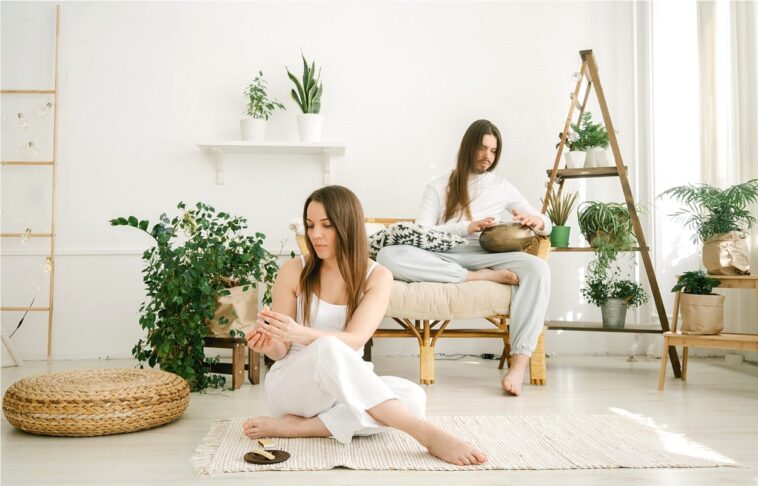Creating a dedicated meditation room in your home can provide a sanctuary for relaxation, self-reflection, and inner peace. Having a designated space where you can escape the noise and distractions of daily life can greatly enhance your meditation practice. In this article, we will explore the seven best ideas for creating a meditation room that promotes tranquility and mindfulness.
Read More: Designing a Stylish Home Gym in 2023
Explore the Contents
- 1 Benefits of Having a Meditation Room
- 2 Choosing the Right Location
- 3 Creating a Calming Atmosphere
- 4 Essential Meditation Room Supplies
- 5 Incorporating Personal Touches
- 6 Soundproofing the Meditation Room
- 7 Adding Greenery and Plants
- 8 Setting Up a Meditation Altar
- 9 Integrating Technology
- 10 Maintaining the Meditation Room
- 11 Creating a Meditation Corner
- 12 Benefits of Natural Light
- 13 Incorporating Aromatherapy
- 14 Conclusion
- 15 FAQs
Benefits of Having a Meditation Room
A meditation room offers numerous benefits for your mental and physical well-being. It provides a peaceful and serene environment that allows you to disconnect from the outside world and focus on your inner self. Regular meditation has been shown to reduce stress, improve concentration, enhance emotional well-being, and promote better sleep. By dedicating a specific space for meditation, you can establish a routine and make it a regular part of your daily life.
Choosing the Right Location
When selecting a location for your meditation room, it’s essential to find an area within your home that promotes tranquility and minimal distractions. Look for a space that is quiet, away from high-traffic areas, and preferably has natural light. Consider repurposing an underutilized room, a corner of your bedroom, or even a walk-in closet. The key is to choose a location where you feel comfortable and can easily focus on your meditation practice.
Creating a Calming Atmosphere
To create a calming atmosphere in your meditation room, pay attention to the colors, lighting, and overall ambiance. Choose soft, muted colors like light blues, greens, or neutrals to evoke a sense of tranquility. Incorporate natural elements such as indoor plants, rocks, or a small water feature to bring a touch of nature indoors. Soft, warm lighting or the gentle flicker of candles can add a soothing effect to the space.
Essential Meditation Room Supplies
To fully enjoy your meditation sessions, it’s important to have the right supplies in your meditation room. Invest in a comfortable meditation cushion or a meditation chair to provide proper support and posture during your practice. Ambient sounds, such as nature sounds or calming music, can help create a peaceful environment. Consider using a meditation timer or a smartphone app to guide your practice and keep track of time.
Incorporating Personal Touches
Personalizing your meditation room with meaningful decorations and objects can enhance the overall experience. Display inspirational quotes or affirmations on the walls. Hang artwork or photographs that evoke a sense of calmness and serenity. Place objects that hold personal significance or bring you joy, such as crystals, statues, or spiritual symbols. The goal is to create a space that reflects your unique personality and inspires tranquility.
Soundproofing the Meditation Room
To create a quiet and peaceful environment, it’s important to minimize outside noise and distractions. Consider using soundproofing techniques such as installing soundproof curtains, carpets, or acoustic panels on the walls. If your meditation room is located near a busy street or noisy area, using a white noise machine or playing soft background music can help mask unwanted sounds and promote a more immersive meditation experience.
Adding Greenery and Plants
Incorporating plants into your meditation room can have numerous benefits. Not only do they add a touch of natural beauty, but they also improve air quality and create a soothing atmosphere. Choose low-maintenance plants such as peace lilies, snake plants, or pothos, which thrive in indoor environments. Their presence can help purify the air and promote a sense of tranquility and harmony.
Setting Up a Meditation Altar
Creating a meditation altar can serve as a focal point in your meditation room and enhance the spiritual aspect of your practice. Choose a dedicated space or a small table where you can arrange meaningful objects. This can include items like candles, incense, crystals, statues, or personal mementos. The meditation altar acts as a symbolic representation of your intentions and can help create a sacred space for your practice.
Integrating Technology
While technology may seem contradictory to the idea of a meditation room, there are ways to incorporate it to enhance your practice. Meditation apps and guided meditation recordings can provide structure and guidance, especially for beginners. Ambient music or sounds of nature can create a relaxing backdrop for your meditation sessions. Just remember to use technology mindfully and avoid excessive distractions.
Maintaining the Meditation Room
To optimize your meditation sessions, it’s important to keep the space clean, organized, and free from distractions. Regularly dust and clean the surfaces, and ensure that any clutter is removed. Consider incorporating storage solutions like shelves or baskets to keep your meditation supplies organized. Establish a routine for cleaning and tidying up the room to maintain its peaceful ambiance.
Creating a Meditation Corner
If you have limited space, don’t worry. You can still create a dedicated meditation corner that allows you to practice mindfulness. Choose a small area in your home, such as a corner of a room or even a window nook. Use a meditation cushion or a small mat, along with a few meaningful decorations, to transform the space into a tranquil sanctuary.
Benefits of Natural Light
Natural light can greatly enhance the meditation experience. If possible, choose a meditation room with windows or skylights to allow natural light to fill the space. Natural light promotes a sense of openness, positivity, and connection with the outside world. Position your meditation cushion or chair near the window to enjoy the soothing rays of sunlight during your practice.
Incorporating Aromatherapy
Aromatherapy can complement your meditation practice by creating a calming and relaxing atmosphere. Use essential oils and a diffuser to infuse the room with soothing scents like lavender, chamomile, or sandalwood. The gentle aroma can help you relax, reduce stress, and deepen your meditation experience. Experiment with different essential oils to find the scents that resonate with you the most.
Conclusion
Creating a meditation room in your home can be a transformative experience. By following these seven best ideas, you can design a space that promotes tranquility, mindfulness, and inner peace. Remember to choose a suitable location, create a calming atmosphere, incorporate personal touches, and select the right supplies. Whether you have an entire room or just a small corner, a meditation space can become a sanctuary for self-reflection and well-being.
Read More: 9 Best Tips for Creating a Relaxing Outdoor Lounge
FAQs
Q: Do I need a dedicated room for meditation?
While having a dedicated room can be ideal, you can create a meditation corner in any space, big or small.
Q: Can I use scented candles instead of essential oils for aromatherapy?
Yes, scented candles can provide a similar calming effect, but ensure they are made from natural materials.
Q: How often should I clean and maintain my meditation room?
It’s recommended to clean and organize your meditation room regularly to maintain a peaceful environment.
Q: Can I incorporate yoga exercises in my meditation room?
Yes, you can use your meditation room for both meditation and gentle yoga exercises.
Q: Is it necessary to soundproof the meditation room?
Soundproofing can help minimize distractions, but it’s not mandatory. You can find other ways to create a quiet environment.



